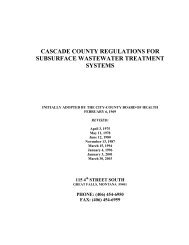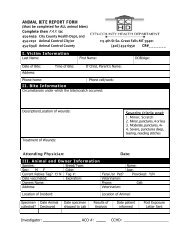Historic Dates and Events Related to Vaccines and Immunization
Historic Dates and Events Related to Vaccines and Immunization
Historic Dates and Events Related to Vaccines and Immunization
Create successful ePaper yourself
Turn your PDF publications into a flip-book with our unique Google optimized e-Paper software.
<strong>His<strong>to</strong>ric</strong> <strong>Dates</strong> <strong>and</strong> <strong>Events</strong> <strong>Related</strong> <strong>to</strong> <strong>Vaccines</strong> <strong>and</strong> <strong>Immunization</strong><br />
manufacturing anti<strong>to</strong>xins <strong>and</strong> vaccines while benefiting the manufacturers already in compliance. Ten firms held licenses with the<br />
Labora<strong>to</strong>ry of Hygiene following the 1902 Act.<br />
1901 In St. Louis, 13 children died of tetanus-contaminated diphtheria anti<strong>to</strong>xin. In the autumn of 1901, nine children in Camden, New Jersey,<br />
died from tainted smallpox vaccine. Efforts <strong>to</strong> ensure the purity of biological treatments by government oversight followed with the<br />
Biologics Control Act of 1902.<br />
1901 The first Nobel Prize for Physiology <strong>and</strong> Medicine was awarded <strong>to</strong> Emil von Behring for his work on the development of a diphtheria<br />
anti<strong>to</strong>xin (later known as antiserum).<br />
1897 Plague vaccine was introduced, following the preparation of anti-plague horse serum at the Pasteur Institute by Alex<strong>and</strong>re Yersin. After<br />
demonstrating protection from disease in immunized animals, Yersin went <strong>to</strong> China with the vaccine <strong>to</strong> protect humans during a plague<br />
epidemic.<br />
1896 Cholera <strong>and</strong> typhoid vaccines were first developed.<br />
1893 City <strong>and</strong> state public health departments began mass production of diphtheria anti<strong>to</strong>xin, following its introduction in European<br />
labora<strong>to</strong>ries.<br />
1888 The Pasteur Institute was established as a rabies treatment center as well as an infectious diseases research <strong>and</strong> training institute.<br />
1888 The diphtheria <strong>to</strong>xin was discovered by Emile Roux. Passive serum therapies were developed through the scientific contributions of<br />
many, including Emil Von Behring who developed the first effective therapeutic serum against diphtheria <strong>and</strong> Paul Ehrlich who<br />
developed enrichment <strong>and</strong> st<strong>and</strong>ardization pro<strong>to</strong>col, which allowed for an exact determination of quality of the diphtheria anti<strong>to</strong>xins.<br />
1887 Joseph Kinyoun established one of the country's first bacteriological labora<strong>to</strong>ries in the Marine Health Service Hospital on Staten Isl<strong>and</strong>,<br />
NY. He was direc<strong>to</strong>r of the Labora<strong>to</strong>ry of Hygiene, which moved <strong>to</strong> Washing<strong>to</strong>n, D.C., in 1891. Kinyoun brought the latest techniques<br />
such as the procedure for preparing diphtheria anti<strong>to</strong>xin back from his visits <strong>to</strong> Europe.<br />
1885 Louis Pasteur first used rabies vaccine in humans.<br />
1884 The first live attenuated viral vaccine (rabies) was developed by Louis Pasteur, using dessicated brain tissue inactivated with<br />
formaldehyde.<br />
1882 Robert Koch identified the tubercle bacillus as the cause of tuberculosis, subsequently called Koch's bacillus.<br />
1881 Louis Pasteur <strong>and</strong> George Miller Sternberg almost simultaneously isolated <strong>and</strong> grew the pneumococcus organism.<br />
1879 Louis Pasteur created the first live attenuated bacterial vaccine (chicken cholera)<br />
1877 Louis Pasteur proposed The Germ Theory of Disease.<br />
1798 Edward Jenner published his work on the development of a vaccination that would protect against smallpox. Two years earlier, in 1796,<br />
he had first speculated that protection from smallpox disease could be obtained through inoculation with a related virus, vaccinia or<br />
cowpox. He tested his theory by inoculating eight-year-old James Phipps with cowpox pustule liquid recovered from the h<strong>and</strong> of a<br />
milkmaid, Sarah Nelmes.<br />
1798 The Marine Health Service was established in 1798 as the nation's first public health agency. It provided hospital care for merchant<br />
seamen <strong>and</strong> protected port cities against diseases such as smallpox, cholera, <strong>and</strong> yellow fever.<br />
1721 Variolation was introduced <strong>to</strong> Great Britain.<br />
1100s<br />
The variolation technique was developed, involving the inoculation of children <strong>and</strong> adults with dried scab material recovered from<br />
smallpox patients. Variations of variolation have been noted in Turkey, Africa, China, <strong>and</strong> Europe.<br />
400 BC Hippocrates described mumps, diphtheria, epidemic jaundice, <strong>and</strong> other conditions<br />
About IAC • Contact Us • Press Room • Cite IAC • Link <strong>to</strong> IAC • A-Z Index • Site Map • Disclaimer • Privacy<br />
<strong>Immunization</strong> Action Coalition • 1573 Selby Ave • St. Paul, MN 55104<br />
tel 651-647-9009 • fax 651-647-9131<br />
email admin@immunize.org<br />
This website is supported in part by a cooperative agreement from the National Center for <strong>Immunization</strong> <strong>and</strong> Respira<strong>to</strong>ry Diseases (Grant No. 5U38IP000290) at the Centers for Disease Control<br />
<strong>and</strong> Prevention (CDC) in Atlanta, GA. The website content is the sole responsibility of IAC <strong>and</strong> does not necessarily represent the official views of CDC.<br />
http://www.immunize.org/timeline/[6/20/2013 5:22:19 PM]








